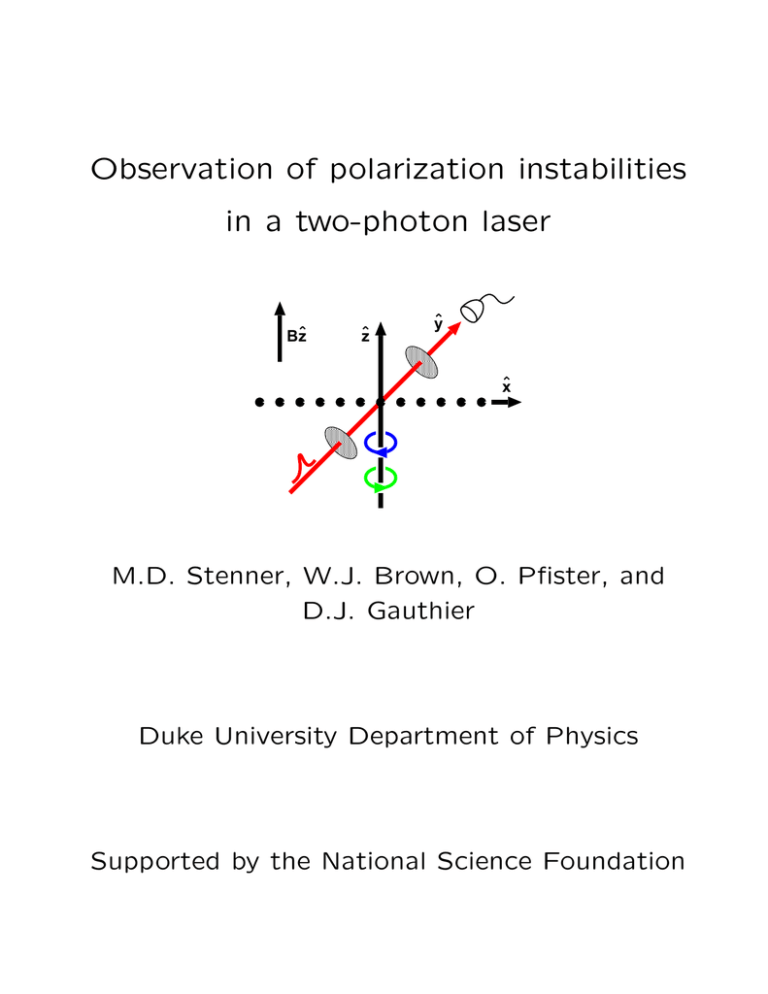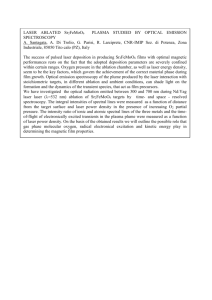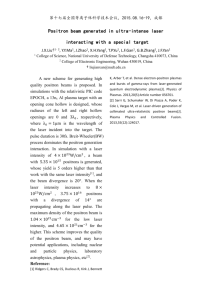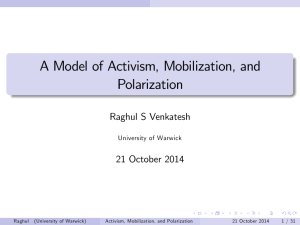Observation of polarization instabilities in a two-photon laser
advertisement

Observation of polarization instabilities in a two-photon laser Bz z y x M.D. Stenner, W.J. Brown, O. Pfister, and D.J. Gauthier Duke University Department of Physics Supported by the National Science Foundation Two-Photon Laser Based on two-photon stimulated emission Ee ωa Ei ωb Eg ωa ωb Proposed by Prokhorov, Sorokin, and Braslau in 1963 and 1964 Two-photon maser built by Brune et al. in 1987 Two-photon laser built by Gauthier et al. in 1992 Two-photon laser has many interesting properties and differs from one-photon laser in many ways. Here, I focus on nonlinear behavior. 2 Ingredients of a Laser one-photon lasers (Schawlow and Townes 1958) Atoms Pump Mechanism Mirror two-photon lasers (Sorokin and Braslau 1964) GAIN + FEEDBACK ⇒ OSCILLATION Review One-Photon Lasers The Atoms Na Nb h ωba a Concentrate on two levels of the atom b 3 The Light-Matter Interactions: One-Photon Processes Spontaneous Emission Ee dNe = −AN e dt ωeg A ∼ 108s−1 Eg Absorption Ee dNg I N = −σ dt h̄ωeg g ωeg σ ∼ 10−9cm2 Eg Stimulated Emission Ee ωeg ωeg ωeg dNe = −σ I N dt h̄ωeg e Eg Photons have same direction, frequency and phase 4 Two-Photon Processes (Goeppert-Meyer, 1931) Spontaneous Emission Ee same parity E i ωa ωa + ωb = ωeg ωb Eg dominant decay mechanism for many metastable transitions (Briet & Teller, 1940) Stimulated Emission Ee ωa Ei ωb Eg ωa = ωb = ωeg 2 ωa ωb dNe = −σ dt µ ¶ I 2 Ne h̄ωa transient two-photon gain (Loy 1978, Schlemmer et al. 1980, Nikolaus et al. 1981) 5 Two-Photon Amplifier Ee Iout Iin Ei ω = 1 ωeg 2 Eg 2 dI I = G(2) dz 1 + I2 Solutions: (2) I 2 for low intensity: dI dz ≈ G for low gain (small G(2)): Iout ∼ Iin(1+G(2)IinL) Iout ∼ Iin Iin −→ 0 Iout Iin (2) I L G in e gain −→ 0 1 0 (2) Isat I in 6 Nonlinearity in one-photon lasers Laser Intensity nonlinearity important laser threshold 0 1 2 3 4 Pump Rate R/Rth 5 P (ω) = χ(ω)E(ω) χ(ω) ∝ ∆N ∝ 1 (1) 1 + I/Isat ≈1− I (1) Isat + ··· (1) (valid when I ¿ Isat ) P (ω) ≈ χ(1)(ω)E(ω) + χ(3)(ω)E 3(ω) For most lasers, nonlinear behavior can be accurately described by the first two terms 7 Laser Intensity I/ (2) Isat Nonlinearity in two-photon lasers 4 nonlinearity 3 important 2 1 0 0 1 0.5 1.5 Pump Rate R/Rth 1 I 2 2 χ(ω) ∝ ∆N ∝ µ ¶2 6≈ 1 − (2) + · · · (2) Isat 1 + I/Isat (2) The expansion does not converge because I ≥ Isat for all operating conditions! This system is highly nonlinear under all operating conditions! 8 Experimental Setup Bz z detector y mirrors x 39 K atoms Raman pump starting pulse optical pumps F ≈ 15, 000 atomic number density ≈ 2 × 1010 cm−3 atoms in cavity ≈ 106 9 Two-Photon Gain via Multi-Photon Scattering Bz z y x 25 MHz F=2 4 2P1 F=1 ωd homogenous width = 5 MHz residual doppler = 30 MHz ωp 2 ωd ωp F=2 4 2S1 ∆ g = 462 MHz F=1 m = -2 m = -1 m=0 Resonance condition: m=1 m=2 ∆g ω d − ωp = 2 10 2 Threshold Behavior of the Two-Photon Laser Laser stable with no photons in the cavity until perturbed by injected pulse Laser is stable at ≈ 3 µW 11 Observation of Polarization Instabilities We now place a linear polarizer after the laser added linear polarizer Total intensity is constant, but intensity in a single polarization oscillates at f = 9.1 MHz. The intensity is stable, but the polarization is unstable. Both periodic and random-like oscillations occur for different magnetic field strengths. 12 Magnetic Field Dependence 13 How can we have polarization instabilities? Bz z y x We have seen that the two-photon laser is highly nonlinear, so we might expect intensity instabilities, but why would we have polarization instabilities? • Multiple final states • Multiple quantum pathways • Each pathway produces a different polarization • All pathways are frequency degenerate 14 Other pathways ẑẑ shown previously σ̂ −σ̂ + same final state σ̂ +ẑ different final state 15 What determines the polarization instability oscillation frequency? We observe oscillation at f = 9.1 MHz Other relevant frequencies in the experiment: Raman pump detunings ≈ 25 MHz and 256 MHz Natural linewidth ≈ 5 MHz Doppler linewidth ≈ 30 MHz Cavity linewidth ≈ 1 MHz Gain-Cavity detuning unknown (nominally 0) Oscillation frequency is comparable to both cavity linewidth and 39K natural linewidth. We are exploring the gain both experimentally and theoretically to investigate further. 16 Conclusions The two photon laser is a new quantum oscillator with many features that demand investigation. • Highly nonlinear behavior • Complex polarization instabilities • Multiple degenerate quantum pathways starting from same initial state • Possible bright entangled state source 17


